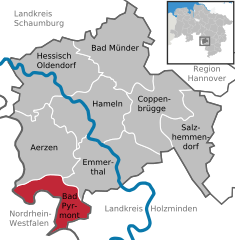This article needs additional citations for verification. (June 2015) |
Bad Pyrmont | |
|---|---|
 Bad Pyrmont Holy Bath | |
Location of Bad Pyrmont within Hameln-Pyrmont district  | |
| Coordinates: 51°59′12″N 09°15′49″E / 51.98667°N 9.26361°E | |
| Country | Germany |
| State | Lower Saxony |
| District | Hameln-Pyrmont |
| Subdivisions | 9 subdivisions |
| Government | |
| • Mayor (2021–26) | Klaus Blome[1] (CDU) |
| Area | |
• Total | 61.96 km2 (23.92 sq mi) |
| Population (2022-12-31)[2] | |
• Total | 19,604 |
| • Density | 320/km2 (820/sq mi) |
| Time zone | UTC+01:00 (CET) |
| • Summer (DST) | UTC+02:00 (CEST) |
| Postal codes | 31812 |
| Dialling codes | 05281 |
| Vehicle registration | HM |
| Website | www |
County (Principality) of Pyrmont Grafschaft (Fürstentum) Pyrmont (German) | |||||||||||
|---|---|---|---|---|---|---|---|---|---|---|---|
| 1194–1918 | |||||||||||
| Status | State of the Holy Roman Empire, State of the Confederation of the Rhine, State of the German Confederation, State of the North German Confederation, State of the German Empire | ||||||||||
| Capital | Lügde | ||||||||||
| Government | Principality | ||||||||||
| Historical era | Middle Ages | ||||||||||
• Partitioned from Schwalenberg | 1194 | ||||||||||
• Comital line extinct; to Spiegelberg | 1494 | ||||||||||
• To Lippe | 1557 | ||||||||||
• To Gleichen | 1583 | ||||||||||
• To Waldeck | 1625 | ||||||||||
| 1668 | |||||||||||
• Regained independence | 1805–12 | ||||||||||
• Prussian administration | from 1868 | ||||||||||
| 1918 | |||||||||||
• Joined Prussian province of Hanover | 1921 | ||||||||||
| |||||||||||
Bad Pyrmont (German: [baːt pʏʁˈmɔnt] , also: [- ˈpʏʁ-]; West Low German: Bad Purmunt) is a town in the district of Hamelin-Pyrmont, in Lower Saxony, Germany, with a population close to 19,000. It is located on the river Emmer, about 10 km (6.2 mi) west of the Weser. Bad Pyrmont is a popular spa resort that gained its reputation as a fashionable place for princely vacations in the 17th and 18th centuries. The town is also the center of the Religious Society of Friends (Quakers) in Germany.
- ^ "Stichwahlen zu Direktwahlen in Niedersachsen vom 26. September 2021" (PDF). Landesamt für Statistik Niedersachsen. 13 October 2021.
- ^ "LSN-Online Regionaldatenbank, Tabelle A100001G: Fortschreibung des Bevölkerungsstandes, Stand 31. Dezember 2022" (in German). Landesamt für Statistik Niedersachsen.



